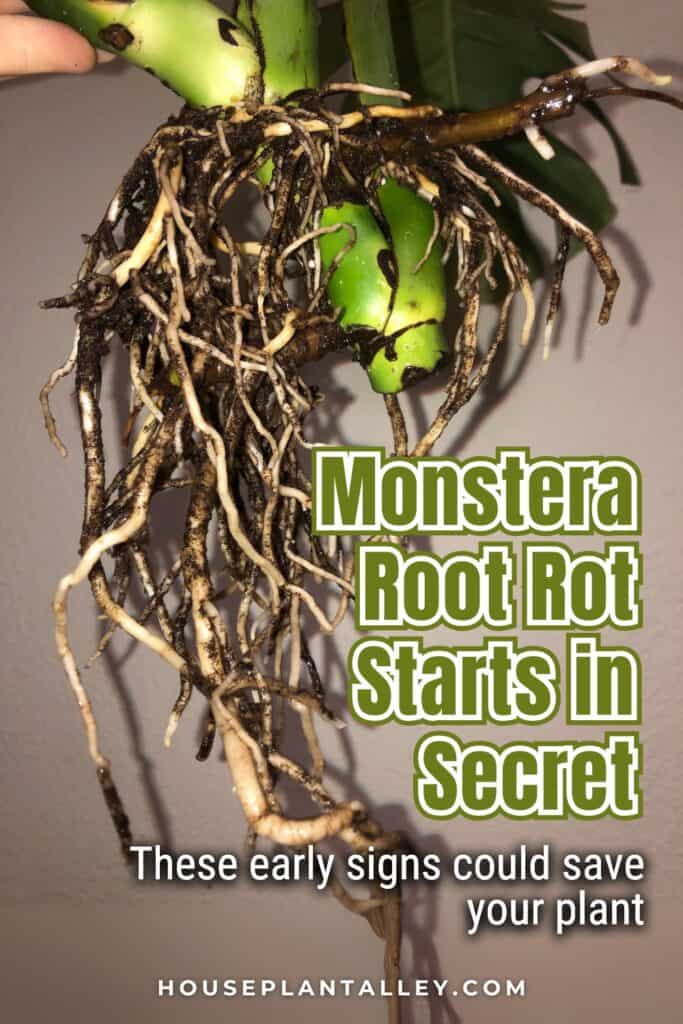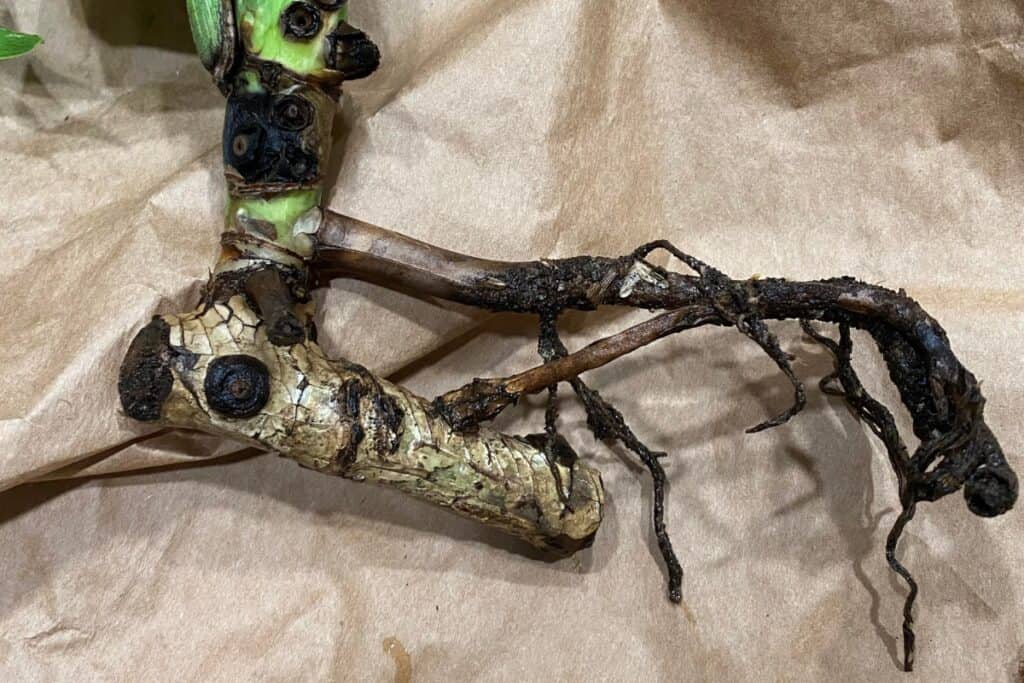Monstera owners often mistake the early signs of root rot for normal plant behavior, a costly error that can destroy an otherwise healthy specimen. Yellowing leaves, mushy black stems, and persistent wilting despite moist soil all signal serious trouble brewing beneath the surface. These symptoms typically appear 2-3 weeks after root damage begins, when anaerobic bacteria have already compromised the plant’s vascular system. The most deceptive aspect involves seemingly minor changes that mask catastrophic internal damage.

Contents
- 1 Understanding Root Rot in Monstera Plants
- 2 Yellowing Leaves: The First Warning Signal
- 3 Mushy Stems and Their Dangerous Implications
- 4 Wilting Despite Adequate Watering
- 5 Curling Leaves and Moisture Conservation
- 6 Black Spots Indicating Advanced Damage
- 7 Stunted Growth From Compromised Root Systems
- 8 Soil Conditions That Promote Root Rot
- 9 Container Issues and Drainage Problems
- 10 Root Inspection and Early Detection Methods
Understanding Root Rot in Monstera Plants
When fungi invade the soil around a Monstera’s roots, they create a destructive condition known as root rot that can quickly kill even the healthiest houseplant. This problem develops when excessive moisture and poor airflow create perfect breeding grounds for harmful microorganisms. Fungal infections thrive in waterlogged environments, attacking the delicate root systems that Monsteras depend on for survival.
Root health deteriorates rapidly once these pathogens establish themselves in the soil. The fungi fundamentally suffocate the roots, preventing them from absorbing water and nutrients properly, which triggers a cascade of visible symptoms throughout the entire plant.
Yellowing Leaves: The First Warning Signal
Yellow leaves act like a plant’s distress signal, alerting Monstera owners that something has gone wrong beneath the soil surface. When roots become waterlogged and begin rotting, they lose their ability to absorb essential nutrients and water effectively. This creates a domino effect where the plant starts cannibalizing its older leaves, turning them yellow as it redirects remaining resources to newer growth.
Understanding yellowing leaves causes helps distinguish root rot from normal aging. Unlike natural leaf yellowing, which affects only the oldest leaves, root rot yellowing spreads rapidly across multiple leaves. Yellowing leaves remedies require addressing the underlying moisture problem immediately.
Mushy Stems and Their Dangerous Implications

Soft, squishy stems signal that root rot has progressed beyond the root system and begun attacking the plant’s structural foundation. Healthy Monstera stems should feel firm and sturdy, like thick straws supporting the plant’s weight. When stems turn mushy, they lose their ability to transport water and nutrients effectively.
The mushy stem causes typically stem from prolonged waterlogged conditions that weaken cellular structure. Unfortunately, stem recovery techniques are limited once this stage develops. Immediate action involves cutting above affected areas with sterile tools, then propagating healthy sections in fresh soil or water to salvage the plant.
Wilting Despite Adequate Watering
Paradoxically, Monstera leaves droop and wilt even when owners maintain consistent watering schedules, creating confusion about whether the plant needs more or less water. This counterintuitive symptom occurs because damaged roots cannot transport root moisture effectively throughout the plant, despite adequate soil hydration.
The wilting happens when compromised roots fail to absorb water properly, leaving leaves dehydrated regardless of watering frequency. Plant stress intensifies as owners mistakenly increase watering, worsening the underlying rot problem. Before adding more water, check soil moisture levels and examine root health to distinguish between underwatering and overwatering symptoms.
Curling Leaves and Moisture Conservation
When Monstera leaves curl inward along their edges, the plant activates an ancient survival mechanism designed to reduce surface area and conserve precious moisture. This curling behavior indicates leaf stress, though determining the root cause requires careful investigation. While curling typically signals underwatering, root rot creates identical symptoms through damaged roots that cannot absorb water properly.
The plant’s moisture retention strategy becomes counterproductive when roots are compromised. Brown patches or crispy edges alongside curling suggest true dehydration, while soft stems indicate overwatering issues masquerading as drought stress.
Black Spots Indicating Advanced Damage
Black spots appearing on Monstera stems and leaves signal that root rot has progressed beyond the underground root system and begun attacking visible plant tissue. These dark, sunken patches have a waterlogged appearance and feel soft to the touch. Advanced root rot at this stage requires immediate action through aggressive pruning.
Black spot treatment involves cutting away all affected areas with sterilized scissors, removing tissue well beyond visible damage. Unfortunately, when spots spread extensively across stems and leaves, the infection may be too advanced for recovery, potentially requiring plant disposal to prevent contamination.
Stunted Growth From Compromised Root Systems
Why does a Monstera suddenly stop producing new leaves despite receiving regular care? When root system health deteriorates from rot, the plant cannot absorb essential nutrients and water needed for growth. Photosynthesis fundamentally halts because damaged roots fail to transport resources throughout the plant.
Before diagnosing root rot, consider other growth inhibitors like insufficient light, nutrient deficiencies, or seasonal dormancy. However, stunted growth combined with yellowing leaves and soggy soil strongly suggests compromised roots. Healthy Monsteras produce new leaves every 4-6 weeks during growing season, so prolonged stagnation warrants immediate root inspection and corrective action.
Soil Conditions That Promote Root Rot
Understanding the soil environment reveals why some Monsteras thrive while others struggle with persistent root rot issues. Poor soil aeration creates oxygen-starved conditions that allow harmful fungi to flourish around root systems. Dense, compacted soil prevents air circulation, trapping carbon dioxide and creating anaerobic pockets where pathogens multiply rapidly.
Excessive moisture retention compounds the problem considerably. Heavy clay soils, potting mixes without drainage amendments, and containers lacking proper holes create waterlogged conditions. Soil particles can block drainage pathways over time, making previously well-draining mixes problematic. Adding perlite, bark chips, or coarse sand improves both aeration and drainage capabilities effectively.
Container Issues and Drainage Problems
While soil composition sets the foundation for healthy root systems, the container itself can sabotage even the best potting mix through inadequate drainage design. Many decorative pots lack drainage holes entirely, creating waterlogged conditions that guarantee root rot within weeks.
Smart container selection means choosing pots with multiple drainage holes at least half an inch in diameter. Terracotta naturally wicks moisture, while plastic retains it longer. Heavy containers signal waterlogged soil below seemingly dry surfaces.
Effective drainage solutions include adding pebbles or broken pottery shards to pot bottoms, elevating containers on plant saucers with gravel.
Root Inspection and Early Detection Methods
Before symptoms become visible above soil, root inspection offers the most reliable method for catching root rot in its earliest stages. Carefully remove the plant from its container every 3-4 months for thorough root assessment. Healthy Monstera roots appear white or cream-colored with firm texture, while rotted roots feel mushy and emit foul odors.
Gently rinse soil away to examine root condition properly. Black, brown, or slimy roots indicate infection requiring immediate attention. Early intervention through prompt root trimming and repotting saves plants before damage spreads to stems and leaves, preventing total plant loss.
